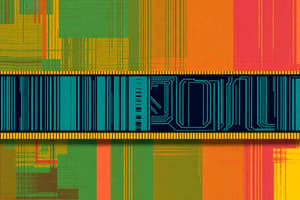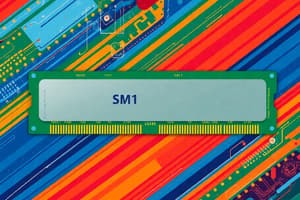Podcast
Questions and Answers
What does the Optimal Algorithm do in page replacement?
What does the Optimal Algorithm do in page replacement?
- Replaces the page with the highest priority
- Replaces the page that is currently least frequently used
- Replaces the page that will not be used for the longest time in the future (correct)
- Replaces the page that has been in memory the longest
Which of the following is a benefit of paged virtual memory?
Which of the following is a benefit of paged virtual memory?
- It allows programs larger than available RAM to execute (correct)
- It reduces the complexity of physical memory layout
- It ensures optimal performance at all times
- It eliminates the need for secondary storage
What is one of the main challenges associated with paged virtual memory?
What is one of the main challenges associated with paged virtual memory?
- It guarantees high speed access to all memory
- It eliminates the need for memory protection
- It simplifies the management of page tables
- It introduces overhead due to TLBs and page tables (correct)
How does paged virtual memory affect system performance?
How does paged virtual memory affect system performance?
What is a key advantage of memory sharing in paged virtual memory?
What is a key advantage of memory sharing in paged virtual memory?
What is the primary purpose of paged virtual memory?
What is the primary purpose of paged virtual memory?
What does a page fault indicate?
What does a page fault indicate?
Which statement best describes the page table?
Which statement best describes the page table?
How does the FIFO page replacement algorithm operate?
How does the FIFO page replacement algorithm operate?
Which component contains the physical frame number if a page is in memory?
Which component contains the physical frame number if a page is in memory?
Which memory concept serves as the logical address space a process sees?
Which memory concept serves as the logical address space a process sees?
What is one drawback of the LRU page replacement algorithm?
What is one drawback of the LRU page replacement algorithm?
What challenges arise from storing the page table in main memory?
What challenges arise from storing the page table in main memory?
Flashcards
What is Virtual Memory?
What is Virtual Memory?
Virtual memory is a technique that allows a computer to use more memory than physically available by dividing the program's address space and physical memory into fixed-size blocks called pages.
What is Virtual Address Space?
What is Virtual Address Space?
The logical address space a process sees, independent of the physical memory. Each process has its own virtual address space.
What is Physical Address Space?
What is Physical Address Space?
The actual physical memory available to the computer.
What is a Page Table?
What is a Page Table?
Signup and view all the flashcards
What is a Page Frame?
What is a Page Frame?
Signup and view all the flashcards
What is a Page Fault?
What is a Page Fault?
Signup and view all the flashcards
What is a Page Replacement Algorithm?
What is a Page Replacement Algorithm?
Signup and view all the flashcards
What is FIFO Page Replacement Algorithm?
What is FIFO Page Replacement Algorithm?
Signup and view all the flashcards
Optimal Algorithm
Optimal Algorithm
Signup and view all the flashcards
Memory Protection
Memory Protection
Signup and view all the flashcards
Memory Sharing
Memory Sharing
Signup and view all the flashcards
Efficient Use of Memory
Efficient Use of Memory
Signup and view all the flashcards
Portability
Portability
Signup and view all the flashcards
Study Notes
Introduction to Paged Virtual Memory
- Paged virtual memory is a memory management technique that allows a computer to use more memory than physically available.
- It achieves this by dividing the program's address space and available physical memory into fixed-size blocks called pages.
- Each program's address space is called a virtual address space; physical memory is called physical address space.
Key Concepts
- Virtual Address Space: The logical address space a process sees, independent of physical memory. Each process has its own virtual address space.
- Physical Address Space: The actual physical memory available to the computer.
- Page Table: A data structure mapping virtual page numbers to physical page numbers. Crucial for translating virtual addresses to physical addresses.
- Page Frame: A fixed-size block of physical memory, same size as a page.
- Page Fault: An interrupt when a requested page isn't in physical memory, requiring loading from secondary storage (e.g., hard drive).
- Page Replacement Algorithm: A method for choosing which page in physical memory to replace when a new page needs to be loaded. Different algorithms impact performance.
Addressing Mechanism in Paged Virtual Memory
- Memory access involves two steps:
- Translation of the virtual address to a physical address.
- Accessing the data at the translated physical address using the page table.
Page Table Structure and Management
- The page table holds mappings between virtual page numbers and physical page numbers.
- Typically implemented in hardware for faster translation.
- Page table entries usually include:
- The physical frame number if the page is in memory.
- Status indicators (present/absent, read/write permissions).
- Other control bits.
- The page table itself resides in main memory due to its size, requiring address translation cycles that need optimization.
Page Replacement Algorithms
- FIFO (First-In, First-Out): Replaces the page in memory longest resident. Simple but often underperforming.
- LRU (Least Recently Used): Replaces the least recently used page. Attempts to predict future page needs, ideally performing better than FIFO.
- Optimal Algorithm: Replaces the page that won't be used for the longest time in the future. Theoretically optimal but impractical since the future isn't predictable.
Benefits of Paged Virtual Memory
- Memory protection: Prevents processes from interfering with each other's memory.
- Memory sharing: Allows processes to share pages, saving memory.
- Efficient memory use: Enables programs larger than physical memory to run by swapping pages in and out.
- Portability: The virtual address space is independent of physical memory, enhancing portability.
Challenges and Issues
- Overhead: Translation lookaside buffers (TLBs) and page tables introduce processing time.
- Performance issues: Page faults significantly impact performance when using secondary storage.
- Complexity: Implementing and managing paged virtual memory is complex.
- Page table management: Efficient strategy required to deal with large page tables' impact.
Relation to Secondary Storage
- Paged virtual memory heavily relies on secondary storage (like hard drives) to store pages not currently in main memory.
- Facilitates running larger processes by moving pages between memory and disk.
- Disk swapping affects performance, creating a balance between memory use and performance.
Studying That Suits You
Use AI to generate personalized quizzes and flashcards to suit your learning preferences.




